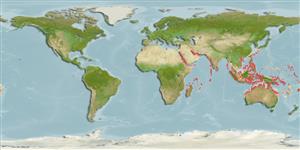Teleostei (teleosts) >
Eupercaria/misc (Various families in series Eupercaria) >
Scaridae (Parrotfishes) > Scarinae
Etymology: Hipposcarus: Greek, ippos = horse + Latin, scarus = a fish cited by ancient writers; 1601 (Ref. 45335).
Environment: milieu / climate zone / depth range / distribution range
Ecology
Marine; reef-associated; non-migratory; depth range 1 - 25 m (Ref. 9710). Tropical
Western Indian Ocean: Red Sea south to Mozambique Channel, including Madagascar and Seychelles and east to Sri Lanka, Maldives and the Chagos Archipelago. Occurrence in Java, Indonesia as reported by Ref. 9710 needs verification.
Size / Weight / Age
Maturity: Lm ? range ? - ? cm
Max length : 75.0 cm TL male/unsexed; (Ref. 5490); common length : 35.0 cm TL male/unsexed; (Ref. 5450); max. published weight: 2.3 kg (Ref. 3488)
Short description
Identification keys | Morphology | Morphometrics
Inhabits coastal regions associated with coral reefs and reef flats. Forms groups consisting of a terminal phased individual and numerous individuals in the initial phase (Ref. 9710). Feeds on benthic algae (Ref. 30573). Caught with nets and other artisanal gear. Mainly sold fresh.
Life cycle and mating behavior
Maturity | Reproduction | Spawning | Eggs | Fecundity | Larvae
Oviparous, distinct pairing during breeding (Ref. 205).
Bruce, R.W. and J.E. Randall, 1984. Scaridae. In W. Fischer and G. Bianchi (eds.) FAO species identification sheets for fishery purposes. (Western Indian Ocean fishing area 51). volume 3. [var. pag.] FAO, Rome. (Ref. 3488)
IUCN Red List Status (Ref. 130435: Version 2025-1)
Threat to humans
Harmless
Human uses
Fisheries: commercial; aquarium: commercial
Tools
Special reports
Download XML
Internet sources
Estimates based on models
Preferred temperature (Ref.
123201): 25.2 - 29.3, mean 28.5 °C (based on 3110 cells).
Phylogenetic diversity index (Ref.
82804): PD
50 = 0.7500 [Uniqueness, from 0.5 = low to 2.0 = high].
Bayesian length-weight: a=0.01318 (0.00847 - 0.02052), b=2.98 (2.85 - 3.11), in cm total length, based on LWR estimates for this species & (Sub)family-body (Ref.
93245).
Trophic level (Ref.
69278): 2.0 ±0.00 se; based on food items.
Generation time: 6.5 ( na - na) years. Estimated as median ln(3)/K based on 2
growth studies.
Resilience (Ref.
120179): Low, minimum population doubling time 4.5 - 14 years (Preliminary K or Fecundity.).
Fishing Vulnerability (Ref.
59153): Moderate to high vulnerability (51 of 100).
🛈
Nutrients (Ref.
124155): Calcium = 29.6 [16.3, 55.6] mg/100g; Iron = 0.544 [0.295, 0.951] mg/100g; Protein = 18.5 [16.5, 20.4] %; Omega3 = 0.0857 [, ] g/100g; Selenium = 35.3 [18.5, 67.6] μg/100g; VitaminA = 46.6 [12.8, 155.6] μg/100g; Zinc = 1.49 [1.03, 2.34] mg/100g (wet weight);
